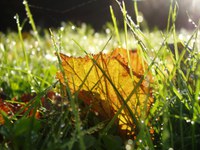Dakota Gardener: Let’s Grow a Great Lawn
(Click an image below to view a high-resolution image that can be downloaded)
By Tom Kalb, Horticulturist
NDSU Extension
If you want a great lawn, now is the time to take action.
September is the best month to sow seed, fertilize, kill weeds and aerate your lawn.
Here are some things you should do this month.
Fill in bare spots. Now through mid-September is the best time to sow grass. The seeds will germinate quickly in the warm soil. As a bonus, weed seedlings rarely germinate in the fall, so we don’t have to worry about them. Awesome!
Choose a high-quality seed mix with a blend of grasses. Most seed mixes will include cultivars of Kentucky bluegrass, fine/red fescues and perennial ryegrass.
Kentucky bluegrass is a hardy grass that should be the predominant grass for sunny areas. The fine/red fescues are best for shade. Perennial ryegrass is a nice addition to a mix because it germinates rapidly and stabilizes the soil while the other lawn grasses emerge.
This also is a terrific time to lay sod. It will quickly “knit” into the ground.
Fertilize. Fall is the most important time to fertilize your lawn. Lawns grow vigorously and grow most of their roots this time of year. If you fertilize your lawn only once a year, do it in September. Labor Day is a good date to target for fertilizing.
Fertilizer has three major components: nitrogen, phosphate and potash. Nitrogen is the most important for turf growth. Look for a fertilizer that has more than 20% nitrogen.
Select a fertilizer with slow-release nitrogen. This fertilizer will promote the growth of roots this fall and provide for a vigorous greening up of the lawn in the spring.
Phosphate is least important because it is already abundant in most soils. Potash will help the lawn become hardy for winter. Look for a “winterizer” fertilizer that has at least 10% potash.
Do not fertilize your lawn if it has not come out of its summer dormancy. You may burn it.
Kill broadleaf weeds. Mid to late September is the best time to kill broadleaf weeds, including dandelions, thistles and clover. As days get shorter, the weeds begin moving nutrients down into their roots to prepare for winter.
This is good for us because a herbicide sprayed on a weed at this time will be absorbed and naturally sent down into the weed’s root system, killing the entire plant. Bye, bye weed!
Aerate. The vast majority of lawns never need to be aerated, but all lawns will enjoy it. September is the best time to aerate the lawn. This is when roots grow, and aeration promotes new roots. Compacted ground (walkways and heavy soils) especially will benefit from aeration.
Hollow tine or core aerators are recommended because they create air pockets by removing plugs of soil/thatch (cores) from the turf. Let the cores dry for a couple of days and then mow to break them up.
Remove cores as deeply as possible (about 3 inches) when aerating. You obtain the best results when the soil is slightly moist but not wet. If the soil is dry, irrigate it one or two days before aerating.
You can fertilize after a core aeration to encourage the recovery of the turf. Lawns may be overseeded after aeration, too.
Now is the time for lawn improvement. Let’s get busy!
For more information about gardening, contact your local NDSU Extension agent. Find the Extension office for your county at https://www.ag.ndsu.edu/extension/directory/counties.
NDSU Agriculture Communication - Sept. 1, 2020
| Source: | Tom Kalb, 701-328-9722, tom.kalb@ndsu.edu |
|---|---|
| Editor: | Ellen Crawford, 701-231-5391, ellen.crawford@ndsu.edu |




